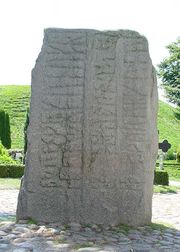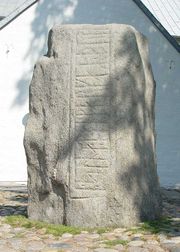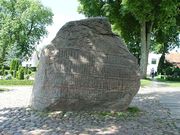Jelling stones
| Jelling Mounds, Runic Stones and Church* | |
|---|---|
| UNESCO World Heritage Site | |
|
|
|
| State Party | |
| Type | Cultural |
| Criteria | iii |
| Reference | 697 |
| Region** | Europe and North America |
| Inscription history | |
| Inscription | 1994 (18th Session) |
| * Name as inscribed on World Heritage List. ** Region as classified by UNESCO. |
|
The Jelling stones are massive carved runestones from the 10th century, found at the town of Jelling in Denmark. The older of the two Jelling stones was raised by King Gorm the Old in memory of his wife Thyra. The runic inscriptions on these stones are considered the most well known in Denmark. [1]
The larger of the two stones was raised by King Gorm's son, Harald Bluetooth in memory of his parents, celebrating his conquest of Denmark and Norway, and his conversion of the Danes to Christianity.
The stones stand in the churchyard of Jelling church between two large mounds. The stones represent the transitional period between the indigenous Norse paganism and the process of Christianization in Denmark. They are strongly identified with the creation of Denmark as a nation state.
After having been exposed to all kinds of weather for a thousand years cracks are beginning to show. On the 15th of November 2008 experts from UNESCO examined the stones to determine their condition. Experts have requested the stones be moved to an indoor exhibition hall, or in some other way protected in situ, to prevent further damage from the weather,[2].
Heritage Agency of Denmark decided to keep the stones in their current location and selected a protective design from 157 projects submited through a competition. The winner of the competition was Nobel Architects. The design features rectangular glass casings strengthened by two solid bronze sides mounted on a supporting steel skeleton. The bronze patina will give off a rusty, greenish colour, highlighting the runestones’ gray and reddish tones and emphasising their monumental character and significance. The glass will be coated with an anti-reflective material that gives the exhibit a greenish hue. A climate system will also keep the inside of the structures at a fixed temperature and humidity. Transoms and other mounting fixtures on the casings will not be visible to visitors.
Although Nobel Architects’ design has won the competition, the Jelling church council must now decide whether the design will be implemented in its existing form or if it should be modified. No date has been given as to when the structures will eventually be completed[3].
Contents |
Runestone of Gorm

The older and smaller of the runestones reads: "King Gormr made this monument in memory of Thyrvé, his wife, Denmark's adornment." (Rundata, DR 41) The Old Norse inscription in Younger Futhark runes appears as follows:

- (side A) ᛬ ᚴᚢᚱᛘᛦ ᛬ ᚴᚢᚾᚢᚴᛦ ᛬
- ᛬ ᚴ(ᛅᚱ)ᚦᛁ ᛬ ᚴᚢᛒᛚ ᛬ ᚦᚢᛋᛁ ᛬
- ᛬ ᛅ(ᚠᛏ) ᛬ ᚦᚢᚱᚢᛁ ᛬ ᚴᚢᚾᚢ
- (side B) ᛬ ᛋᛁᚾᛅ ᛬ ᛏᛅᚾᛘᛅᚱᚴᛅᛦ ᛬ ᛒᚢᛏ ᛬
- (side A) : kurmR : kunukR :
- : k(ar)þi : kubl : þusi :
- : a(ft) : þurui : kunu
- (side B) | sina | tanmarkaR | but |
- (Jacobsen & Moltke, 1941-42, DR 41)
Runestone of Harald Bluetooth

The larger of the two runestones reads: "King Haraldr ordered this monument made in memory of Gormr, his father, and in memory of Thyrvé, his mother; that Haraldr who won for himself all of Denmark and Norway and made the Danes Christian." (Rundata, DR 42)
- (side A)
- ᚼᛅᚱᛅᛚᛏᚱ ᛬ ᚴᚢᚾᚢᚴᛦ ᛬ ᛒᛅᚦ ᛬ ᚴᛅᚢᚱᚢᛅ
- ᚴᚢᛒᛚ ᛬ ᚦᛅᚢᛋᛁ ᛬ ᛅᚠᛏ ᛬ ᚴᚢᚱᛘ ᚠᛅᚦᚢᚱ ᛋᛁᚾ
- ᛅᚢᚴ ᛅᚠᛏ ᛬ ᚦᚭᚢᚱᚢᛁ ᛬ ᛘᚢᚦᚢᚱ ᛬ ᛋᛁᚾᛅ ᛬ ᛋᛅ
- ᚼᛅᚱᛅᛚᛏᚱ (᛬) ᛁᛅᛋ ᛬ ᛋᚭᛦ ᛫ ᚢᛅᚾ ᛫ ᛏᛅᚾᛘᛅᚢᚱᚴ
- (side B)
- ᛅᛚᛅ ᛫ ᛅᚢᚴ ᛫ ᚾᚢᚱᚢᛁᛅᚴ
- (side C)
- ᛫ ᛅᚢᚴ ᛫ ᛏ(ᛅ)ᚾᛁ (᛫ ᚴᛅᚱᚦᛁ ᛫) ᚴᚱᛁᛋᛏᚾᚭ
Transliteration
- (side A)
- haraltr : kunukR : baþ : kaurua
- kubl : þausi : aft : kurm faþur sin
- auk aft : þąurui : muþur : sina : sa
- haraltr (:) ias : sąR * uan * tanmaurk
- (side B)
- ala * auk * nuruiak
- (side C)
- * auk * t(a)ni (* karþi *) kristną
- (Jacobsen & Moltke, 1941-42, DR 42)
Phonetic transcription:
- (side A)
- [ˈharaldr ˈkʰɔnʊŋɡɽ ˈbɑð ˈɡœrwa]
- [ˈkʰʊmbl θøːsi aft ˈɡɔrm ˈfaðʊr siːn]
- [ʌk aft ˈθœrwɪ moːður siːna saː]
- [ˈharaldr ɛs sæːɽ wanː ˈdanmɒrkʰ]
- (side B)
- [ˈalːa ɒkʰ ˈnɔrwɛɣ]
- (side C)
- [ɒkʰ ˈdanɪ ˈɡarðɪ ˈkʰrɪstna]
The stone has a figure of Christ on one side and on another side a serpent wrapped around a lion.
In 1955, a plaster cast of this stone was made for a festival in London. It is now located in the grounds of the Danish Church in London, 4 St. Katherines Precinct, Regents Park, London. The copy is painted in bright colours, like the original. Most of the original paint has flaked away from the original stone, but enough small specks of paint remained to tell us what the colors looked like when they were freshly painted. A copy is also located in the National Museum of Denmark, and another copy just outside the Jelling museum, which lies within sight of the Jelling mounds.[1]
See also
- Boris stones — similar landmarks in Belarus
- Haraldskær Woman
- Jelling style
- Tourism in Denmark
References
- ↑ Jelling stones. Encyclopædia Britannica. 2008. http://www.britannica.com/bps/topic/302453/Jelling-stones.
- ↑ "Eksperter: Runestenene skal reddes". Danmarks Radio. 16 November 2008. http://www.dr.dk/Nyheder/Indland/2008/11/16/085024.htm. Retrieved 16 November 2008.
- ↑ "Jelling Stones get designer cases". Copenhagen Post. 5 March 2010. http://www.cphpost.dk/culture/culture/122-culture/48424-jelling-stones-get-designer-cases.html.
Further reading
- Hogan, C. Michael. "Jelling Stones," Megalithic Portal, editor Andy Burnham
- Rundata, Joint Nordic database for runic inscriptions.
- Jacobsen, Lis; Moltke, Erik (1941-42). Danmarks Runeindskrifter. Copenhagen: Ejnar Munksgaards Forlag.
External links
|
||||||||||